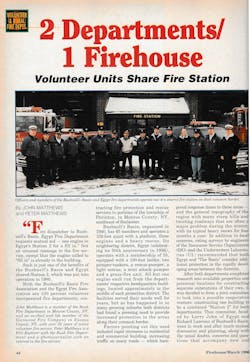40th Anniversary: A Humbling & Rewarding Career
As we started plans for celebrating the 40th anniversary, I came across the March 1995 issue and turned to the back of the book to see the first photo I had published in Firehouse Magazine. It showed Rochester, NY, firefighter Russell Merrick (now a deputy chief and former author of the Firehouse Weekly Drills series) waiting for a water at a house.
A couple of months later, my father, John Matthews (an ex-chief with the Glenwood, NY, Fire Company) pitched a story to then-managing editor Jeff Barrington about two fire departments that shared a fire station in upstate New York. My father and I visited the Bushnell’s Basin/Egypt firehouse, interviewed the members and took some photos, and the article “2 Fire Departments/1 Station” ran in the March 1996 issue.
I started working at Firehouse Magazine in March 1999—a very exciting time for Firehouse. With Firehouse.com online for only a few months, no longer did our readers have to wait weeks or months to read the stories that impacted the fire service.
By the end of my first year at Firehouse, the American fire service responded to many catastrophic events and suffered immeasurable losses. In March, 11 people were killed after an Amtrak train struck a truck in Bourbonnais, IL. In April, 13 students and teachers were gunned down at Columbine High School in Littleton, CO, and in June, 11 people were killed in a plane crash at Dallas/Fort Worth International Airport. Numerous tornadoes and hurricanes caused devastation across the country as well.
Just weeks before I started at Firehouse, three firefighters were killed when the roof of a church collapsed in Lake Worth, TX. That fire would be the cover story for the first issue I worked on, and now that I live nearby, I have talked with some of the firefighters who responded that day.
On a cold Friday night in December, I was having dinner at a pizza shop on Long Island when my beeper went off. The message read that several firefighters were missing at a warehouse fire in Worcester, MA. A couple of phone calls back and forth to Firehouse.com co-founder Dave Iannone confirmed the worst—six firefighters were missing and the warehouse was fully involved.
In the days after the Worcester Cold Storage Fire, the Firehouse.com staff worked around the clock to provide the latest information on the missing and the search efforts to recover them. Firehouse.com was cited by major news organizations hourly, and the forums really brought the fire service community to become one big family.
While the fire service was focused on Worcester that December, three firefighters and three children were killed in a house fire in Keokuk, IA.
The U.S. fire service lost 131 members in the line of duty in 1999.
Fast forward to September 2001, when the world slowed for many of us. The October 2001 issue of the magazine was to be finalized on Sept. 12 and sent to the printers on Sept. 13.
On Sept. 11, the fire service suffered the devastating loss at the World Trade Center, and in order to provide initial coverage, we redesigned much of that issue. We spent three days creating new layouts, gathering details and grasping what happened. As we went to press, the number of dead and injured had not yet been tallied. In just a few days, advertisers like Action Training Systems, Ferrara, Hackney, Medtronic, MSA, Pierce and W.S. Darley redesigned their ads. They simply read “We Remember” or “Thank you.”
For several years after 9/11, there were plenty of new buzzwords and phrases, including terrorism, weapons of mass destruction, IEDs and dirty bombs, to name a few. Articles written by military and private security experts focused on responses to anthrax, IEDs, homemade bombs and various levels of decontamination. Interoperability took on a whole new meaning. Grant money was available for all sorts of equipment, and people were joining fire departments left and right.
It’s been 15 years and terrorism is still on the minds of many, but new buzzwords are filling fire stations across the country: flowpaths, transitional attacks, cancer, bullet proof vests and body armor to name a few.
I joined the Firehouse staff as a young volunteer firefighter, and it opened my eyes to what the fire service is as a whole. I also had the opportunity to work with America’s best fire service instructors, many whose work I read as I grew up.
It has been humbling to talk with fire chiefs who were looking for grant or fundraising ideas as they were struggling to find funding to fuel their apparatus before their next emergency in rural America. Or a fire chief who called in looking for ideas on how to manage certain aspects of their job, whether it was personnel, budgets or city managers.
Dozens of new training officers contacted us looking for ideas for their next drills. The calls always started off the same: “I’m new in the training division and looking or some help. Have you ever published an article on … ?” and within a few minutes, I would be able to pull articles from the pages of Firehouse Magazine or Firehouse.com to send off to them. I’m pretty sure we filled training calendars for a couple thousand training officers.
During interviews with Firehouse Valor (formerly Heroism) or Community Service awardees, the interviewees treated their actions like another day on the job, regardless of whether they collected a check for their extraordinary work. They were always modest and never wanted the recognition. A couple of times while visiting stations, I would be introduced to crews and would say, “I don’t remember the year, but you received the Firehouse Heroism Award for … ” and it seems to be a humbling moment for the both of us.
I would be remiss if I did not thank those who gave me my start here. Former Associate Publisher Jeff Barrington, whom I volunteered with at the Glenwood Fire Company in Long Island, NY, granted me an interview months after I stopped by the office. Both Jeff and Harvey Eisner introduced me to the fire service that I’ve come to know and understand, and I’m grateful for all of their guidance. Also, Lt. Pete Rizzo from the Rochester, NY, Fire Department, who served as my high school internship mentor and the countless firefighters I served with in New York and Maryland. And of course, my father, John, who after 50-plus years continues to get out of bed at 3 a.m. when the pager goes off.
Sadly, since I joined Firehouse, 2,213 firefighters have died in the line of duty, according to U.S. Fire Administration statistics. But the work we do here day after day is meant to honor those fallen heroes by sharing the lessons learned and educating others to avoid similar fates, providing insight on new technology and increasing every responder’s safety.
About the Author
Peter Matthews
Editor-in-Chief/Conference Director
Peter Matthews is the conference director and editor-in-chief of Firehouse. He has worked at Firehouse since 1999, serving in various roles on both Firehouse Magazine and Firehouse.com staffs. He completed an internship with the Rochester, NY, Fire Department and served with fire departments in Rush, NY, and Laurel, MD, and was a lieutenant with the Glenwood Fire Company in Glenwood Landing, NY. Matthews served as photographer for the St. Paul, MN, Fire Department and currently is a photographer for the Fort Worth, TX, Fire Department.

